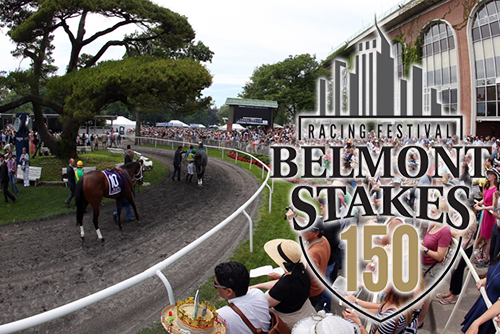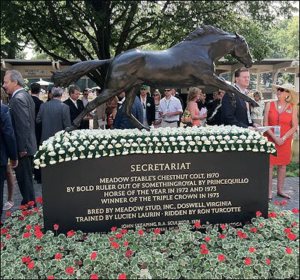
Belmont Stakes Betting Guide
 The Kentucky Derby is unquestionably the most popular event in North American Thoroughbred racing, and during the Preakness Stakes, it is always interesting to see if the Derby champion can take the next step towards capturing the Triple Crown.
The Kentucky Derby is unquestionably the most popular event in North American Thoroughbred racing, and during the Preakness Stakes, it is always interesting to see if the Derby champion can take the next step towards capturing the Triple Crown.
But you could also make the argument that horse racing saves its best for last with the Belmont Stakes. In addition to being the final leg of the Triple Crown, the Belmont’s 1.5-mile distance makes it the greatest test that three-year-old stallions and fillies will face, and many of the greatest surprise stories in the sport have been written at historic Belmont Park.
In this Belmont Stakes betting guide, we’ll cover everything you need to know about one of the oldest and most prestigious horse races in the world.
When Is the Belmont Stakes?
The Belmont Stakes annually takes place on either the first or second Saturday of June. The exact date of the event is dependent on when the Kentucky Derby takes place, since the Belmont is always five weeks after the Derby and three weeks after the Preakness Stakes. Spacing the three races out this way allows the top three-year-old Thoroughbreds in the nation to compete in all of them and have a chance at winning the Triple Crown.
The Belmont is held at Belmont Park, located in Elmont, New York. Post time is generally around 6:30 p.m. Eastern (the 2018 race is slated to start at 6:37), and NBC has televised the race nationwide since 2011.
Best Sites for the Belmont Stakes
The Belmont Stakes is one of the must-bet sporting events of the year, making it an opportune time for betting sites all over the world to try to attract new customers with enticing promotions and bonus offers.
However, it takes more than a great signup bonus to make a great Belmont Stakes betting site. The most important thing is to know that your money is safe and that you’ll be able to withdraw your winnings without any headaches, so you need to make sure any site you join has a stellar history of payouts and reliability. Getting the best odds (they vary by site) and having access to a wide array of betting options may be secondary in importance, but they’re also essential to ensuring that you have a pleasurable Belmont Stakes betting experience.
Based on our years of experience in the online gambling industry, here are the sites we most recommend using for the Belmont Stakes this year.
| RANK | GAMBLING SITE | BONUS | PRODUCT OFFERS | REVIEW | VISIT |
|---|---|---|---|---|---|
| 1 |  |
€30 | 



|
READ REVIEW | VISIT SITE |
| 2 |  |
€200 | 



|
READ REVIEW | VISIT SITE |
| 3 |  |
Get €30 | 



|
READ REVIEW | VISIT SITE |
Previous Belmont Stakes Winners
The finish line of the Belmont Stakes has produced tons of drama over the years.
Not only was it the final hurdle to clear for a dozen Triple Crown winners, but it also spoiled the hopes of 23 other Triple Crown hopefuls who had already won the Kentucky Derby and the Preakness Stakes earlier in the season. Of those 23 horses who couldn’t finish off the Triple Crown with a victory at Belmont, eight of them finished second, while five others placed third.
Despite its gruelingly-long distance, the Belmont has also seen three fillies ride to victory, most recently Rags to Riches in 2007. That may not sound like a lot, but only 23 female horses have entered the Belmont in the race’s history.
Here’s a recap of all the champions in Belmont Stakes history, with Triple Crown winners noted with an *:
- 2017: Tapwrit
- 2016: Creator
- 2015: American Pharoah*
- 2014: Tonalist
- 2013: Palace Malice
- 2012: Union Rags
- 2011: Ruler on Ice
- 2010: Drosselmeyer
- 2009: Summer Bird
- 2008: Da’Tara
- 2007: Rags to Riches
- 2006: Jazil
- 2005: Afleet Alex
- 2004: Birdstone
- 2003: Empire Maker
- 2002: Sarava
- 2001: Point Given
- 2000: Commendable
- 1999: Lemon Drop Kid
- 1998: Victory Gallop
- 1997: Touch Gold
Track Information
The dirt track at Belmont Park is 1.5 miles long, meaning that the Belmont Stakes race is exactly one lap of the track. But despite the fact that the horses have a long straightaway on which to run before they have to make their first turn, the inside lane has been extremely favorable over the years. As of 2013, 23 Belmont champions had started in rail position, nearly twice the number of winners from any other post position (Post 3 and Post 5 had both produced 13 winners).
Belmont Park’s track is known for being one of the best-kept racing surfaces in the country, a necessity to protect horses who have been through the grind of the Kentucky Derby and Preakness Stakes in recent weeks. However, the depth of the surface nicknamed “the Big Sandy” can also be extremely tiring to the horses, especially in wet conditions.
“They have a great grounds crew, but the track changes every day and sometimes it gets really deep,” trainer John Forbes told NewJersey.com in 2015. “It’s much harder for a horse to run over a deep track. It’s much more tiring, and remember in the Belmont they are asked to run farther than all of them will ever run the rest of their lives.”
Belmont Stakes Records
Fastest Time
 The fastest time at the Belmont Stakes was posted by the G.O.A.T. of Thoroughbred racing, Secretariat. The legendary stallion crossed the line of the 1973 race in a time of 2:24 flat, also posting the fastest half-mile, three-quarter-mile, and one-and-one-quarter-mile times in the history of the Belmont.
The fastest time at the Belmont Stakes was posted by the G.O.A.T. of Thoroughbred racing, Secretariat. The legendary stallion crossed the line of the 1973 race in a time of 2:24 flat, also posting the fastest half-mile, three-quarter-mile, and one-and-one-quarter-mile times in the history of the Belmont.
Not only did Secretariat’s win at Belmont secure the final leg of his Triple Crown, but it also made him the record-holder at each of the Triple Crown races. Those records still stand today, although Secretariat wasn’t officially recognized as the record-holder at the Preakness until his time was reviewed in 2012.
To put Secretariat’s Belmont Stakes record in further perspective, no other horse has completed the race in less than 2:26 since the distance was permanently changed to 1.5 miles in 1926. Easy Goer is second on the all-time list at 2:26 flat.
Biggest Winning Margin
In case you were thinking that Secretariat’s 1973 record time might have been influenced by a fast track, think again. No horse was within 31 lengths of Secretariat by the time he crossed the finish line, a margin of victory that easily remains the largest in the history of the Belmont.
And while the longer distance of the Belmont can lead to a larger separation of the pack by the finish, Secretariat did most of his pulling away in the first half of the race. He had a 28-length advantage over his nearest competitor by the midpoint of the Belmont, then added “just” three more lengths to his lead in the final three-quarters of a mile.
Count Fleet (1943) and Man o’ War (1920) are the only other horses in Belmont Stakes history to win the race by 20 lengths or more. The largest margin of victory at the Belmont this century was Point Given’s 12 ¼ length advantage in 2001, and no other horse has won by more than eight lengths since 1990.
Biggest Field
Although the Belmont Stakes limits its field to 16 participants, it has never seen that many horses in the field. The largest field to ever compete in the Belmont came in 1983 when 15 horses raced in the event. That broke the previous record of 14, which dated all the way back to 1875.
The Belmont nearly featured a full field of 16 horses in 1996, which would have required the use of an auxiliary two-stall starting gate to complement the permanent 14-stall gate at the track. However, four horses pulled out of the Belmont in the days leading up to the race.
Smallest Field
The Belmont Stakes has seen as few as two horses in its field on five different occasions. However, all of those times (1887, 1888, 1892, 1910, and 1920) came in the early years of the event and before the Triple Crown had been established as a milestone for Thoroughbreds and their trainers to aspire for.
As the years went by, the prize money for the Belmont Stakes increased, leading to an increase in the size of the fields. However, the Belmont’s field is also typically limited by the high entry fees required to enter a horse as well as the event’s strict qualifying rules.
Winner with the Highest Odds
Savara shocked the world in 2002 when he came out of nowhere to win the Belmont Stakes by half a length, cashing the biggest ticket (70:1) odds for any winner in the history of the race. However, the race was remembered more for who didn’t win that year.
War Emblem was a massive favorite to win the 2002 Belmont, paying slightly higher than even money following his wire-to-wire wins in the Kentucky Derby and Preakness Stakes. But War Emblem’s Triple Crown hopes were essentially dashed by a poor start to the Belmont when he stumbled badly and fell several lengths behind the rest of the field. Though War Emblem charged back to take the lead with half a mile to go, he ran out of energy down the stretch and ended up a distant eighth.
Other surprising winners in recent Belmont Stakes history came in 1980 (Temperence Hill, who paid 53:1), 2008 (Da’ Tara, 38:1), 2004 (Birdstone, 36:1), and 1999 (Lemon Drop Kid, 30:1). And don’t be surprised if we see another shocking Belmont winner this year. As of 2018, only three of the past 10 Belmont champions paid lower than 12:1 odds.
Most Successful Trainers
Although Bob Baffert is on the verge of becoming the winningest trainer in the history of both the Kentucky Derby and Preakness Stakes, his horses haven’t been anywhere near as successful at the Belmont. Only two of Baffert’s horses have won the final leg of the Triple Crown, a number that pales in comparison to the number of champions he’s trained in the Preakness (six) and Derby (five).
The two winningest trainers in the history of the Belmont did the majority of their work over 100 years ago. James Rowe worked with eight winners between 1883-1913, while Sam Hildreth produced seven Belmont champs from 1899-1924. A notable third on the list is Jim Fitzsimmons, whose horses won five of the 10 Belmont Stakes during the 1930s – including Triple Crown winners Gallant Fox and Omaha.
Most Successful Jockeys
Technically, James McLaughlin and Eddie Arcaro are tied for the most wins by a jockey at the Belmont Stakes, each collecting six.
However, Arcaro deserves the edge in this department because McLaughlin’s wins came against some small fields in the 1880s, including two-horse races in 1887 and 1888. Arcaro’s name is certainly no stranger to horse racing enthusiasts since he also holds or shares the lead for the most jockey wins in the Kentucky Derby and Preakness Stakes.
Laffit Pincay Jr. is the only jockey besides McLaughlin to win three consecutive Belmont Stakes, riding the victorious horse each year from 1982-84. Interestingly, although Pincay went on to become the winningest jockey in the history of flat racing (he’s now second), those were the only three Belmont wins of his career. In fact, he only won one other Triple Crown race, the 1984 Kentucky Derby.
History of the Belmont Stakes
 The Belmont Stakes is the oldest of the three Triple Crown races, dating back all the way to 1867. If an anti-gambling bill in the state of New York hadn’t resulted in the cancellation of the Belmont Stakes in 1911 and 1912, the Belmont would supplant the Kentucky Derby as the longest-running sporting event in the United States. As it stands, the Belmont is still the fourth-oldest horse race in North America and ranks behind only the Phoenix Breeders’ Cup and Canada’s Queen’s Plate in total runnings.
The Belmont Stakes is the oldest of the three Triple Crown races, dating back all the way to 1867. If an anti-gambling bill in the state of New York hadn’t resulted in the cancellation of the Belmont Stakes in 1911 and 1912, the Belmont would supplant the Kentucky Derby as the longest-running sporting event in the United States. As it stands, the Belmont is still the fourth-oldest horse race in North America and ranks behind only the Phoenix Breeders’ Cup and Canada’s Queen’s Plate in total runnings.
The event is named after former New York businessman August Belmont, the horse owner and breeder who founded the race. The Belmont Stakes were initially held at Jerome Park in the Bronx, then at nearby Morris Park Racecourse until Belmont’s son, August Belmont Jr., built Belmont Park in 1905 in his father’s honor. Belmont Park has been the home to the event ever since, except for a four-year period from 1963-67 when the race moved to Aqueduct Racetrack while Belmont Park was being renovated and updated.
The race has been 1.5 miles long ever since 1926 when organizers finally settled on a distance after changing it numerous times throughout the 1880s and early 1900s. Due to its extreme length, the Belmont is commonly known as “The Test of the Champion,” a fitting nickname for a race that is the last leg of the Triple Crown.
Interest in the Belmont always peaks when a horse has a chance to win the Triple Crown after capturing the Kentucky Derby and Preakness Stakes in previous weeks. A then-record crowd of more than 80,000 people attended the 1971 Belmont to see if Canonero II could claim the Triple Crown (he didn’t, falling victim to a foot infection and finishing fourth). And massive throngs of more than 100,000 came to see the Belmont three straight years from 2002-04 as War Emblem, Funny Cide, and Smarty Jones all failed in their attempt to win it as well.
It may not be “The Most Exciting Two Minutes in Sports” like the Kentucky Derby, but the Belmont Stakes regularly delivers thrills to horse racing fans in a different way.
As the longest race in American Thoroughbred racing, the Belmont is a unique test of both speed and stamina, making no lead safe until the horses cross the finish line. And when one of the participants has already won the Kentucky Derby and Preakness Stakes, millions of viewers are glued to their sets to see if history will be made by another Triple Crown winner.
With so many surprise winners over the years, the Belmont is also a great opportunity to hit a big return on one of the many dark horses who are capable of winning. If you’ve never bet on the Belmont Stakes before, you owe it to yourself to give it a try.